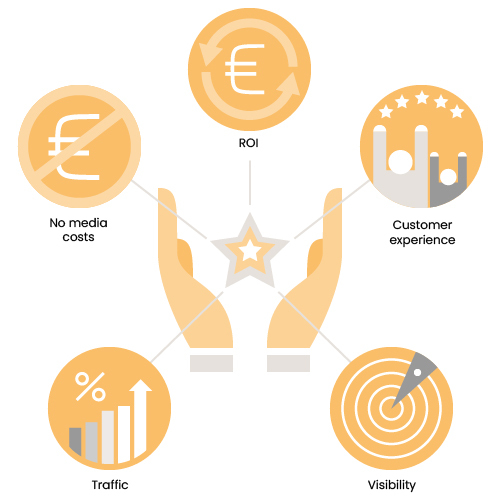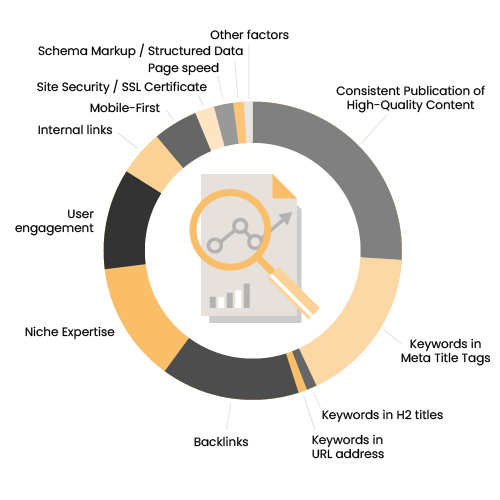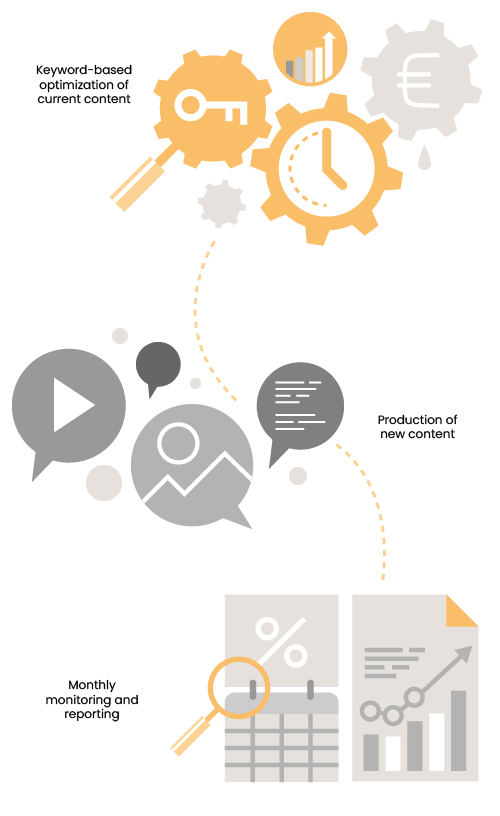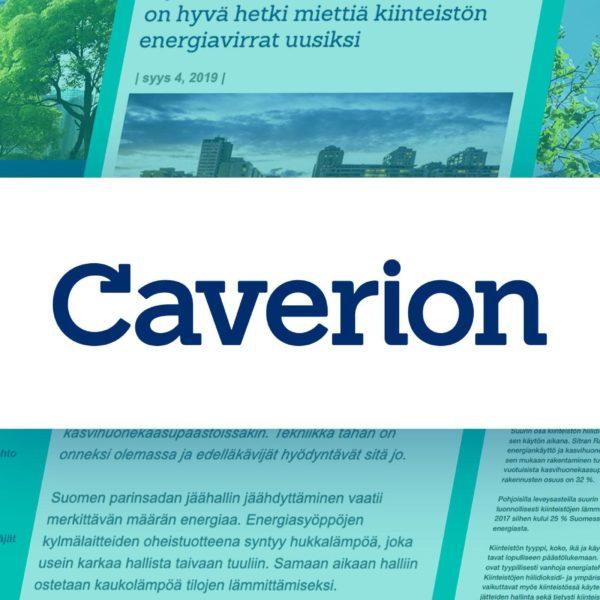Search engine optimization (SEO) produces the best results as an ongoing service
SEO is an effective way to attract visitors to a website. Through SEO, the content and technical functionality of the site are optimized to match user searches and visibility in search engines.
Request a quoteWhy is search engine optimization important?
Organic traffic from search engines typically constitutes the majority of visitors to most websites. People all over the world continue to make billions of searches on search engines daily, so the volumes are significant. Also, users who arrive through search engines usually have a clear intention to visit the website – perhaps they are conducting initial research or comparing potential solutions to their problem.
In addition to search engine advertising, SEO is the best way to tap into this potentially lucrative traffic. Unlike advertising, search engine optimization does not require payment for the media or visibility on search engines. Therefore, well-executed SEO work yields long-term and cost-effective results. In principle, once the work is done well, it generates traffic year after year.
However, search engine optimization is often misunderstood – the best results are achieved through an ongoing effort, rather than perceiving it as a one-time project.

Benefits of search engine optimization
Anyone who owns a website and wants to drive traffic to it can benefit from search engine optimization. The optimization work may cost (in terms of hours spent if done by oneself, or money if purchased as a service), but it produces results without the need to spend money on advertising.
- More traffic and relevant traffic from search engines
- No media costs (only labor costs)
- Possibility of high ROI
- Consistent customer experience (discoverability, non-disruptive)
- Increased visibility for the brand.
A weakness of SEO work is that it rarely produces immediate results. The rise of pages in search engine results may take time. There are also no guarantees that the website will eventually appear in search results, although the results of well-done work are usually clearly visible in visitor numbers. Rankings can also decrease when competitors produce better content, so the work never really ends.
Search engine optimization in its simplest form
In its simplest form, search engine optimization involves modifying the text content of a website. It ensures that the page’s metadata (meta title and meta description), URL address, headings at different levels, and body text all speak about the same topic. They are optimized for the same search term – whatever that term may be.
This level can be considered a hygiene factor in keyword optimization. It ensures that search engine robots understand what topic your content is about. When the robots understand the content, they can also display the page’s results with relevant search terms.
An example could be the website of a car repair shop in Kemijärvi. The following template helps Google and its partners’ algorithms display the content with the right terms.
Page main heading (H1): Car Repair Shop in Kemijärvi
Page subheading (H2): Affordable car repair shop in the center of Kemijärvi
URL address: company-name.fi/car-repair-shop-kemijärvi
Meta title: Car Repair Shop in Kemijärvi – Company Name
Meta description: Are you looking for a car repair shop in Kemijärvi? We service and repair all brands.
In addition, the terms “car repair shop” and “Kemijärvi” should appear multiple times in the page’s body text.
It’s not particularly beautiful, nor particularly effective – yet. Even in Finland, the competition for popular search terms is becoming so tough that getting to the first page of search results requires investing in content. In practice, the content needs to serve the intent of users typing the search term into the search engine. Usually, this means that the content needs to be fairly long, at least around 1500 words. Of course, if the search term is in the form of [company name contact information], the user usually only wants that contact information.
A more effective way to do search engine optimization is to do it as a continuous process
The simple model presented above rarely takes you very far. Firstly, it does not start from the genuine needs of users, i.e. the type of content users want to see. It also does not take into account possible technical limitations of the website, which lower the value of the site in the eyes of search engine algorithms.

1. month – Auditions and Research Work
During the first month, we will conduct keyword research. The research aims to identify terms from the keyword space that are relevant to the specific company.
Additionally, we will conduct a website SEO audit using various technical tools such as Ahrefs, Screaming Frog, Google PageSpeed, and Google SearchConsole. As a result of the audit, we will identify the website’s technical issues that, when fixed, would improve search engine rankings. At the same time, we will identify the pages and terms that generate the most traffic.
If the industry is highly competitive, alongside the analysis, we can also perform a competitor SEO analysis. This analysis helps identify possible gaps in our search engine visibility.
Furthermore, we will establish a common goal-setting process to determine what we want to achieve through search engine optimization.
After the first month’s actions, we will have a clear plan on how to improve search engine visibility.

From the second month onwards – Content production and technical corrections
Content production can generally be divided into two parts. Often, the easiest way is to start by editing existing content to better match user searches. This usually involves small text edits (e.g. metadata and headings) as well as expanding the textual content.
The second measure is, of course, creating completely new content to fill gaps in search engine visibility. Content production is done based on keywords and derivatives, meaning that the content is created to answer the searches that are assumed to be most relevant for the business.
At the same time, technical corrections are made to the website, such as speeding up page loading (improves user experience) and helping search engines understand the content on the site.
These measures can be done on a project basis, especially if the website has only a few pages. However, for larger websites, it is more sensible to proceed month by month with a continuous contract. This way, results tracking can be included in the process and the impact of the work can be examined. Valuable knowledge can also be gained about what type of content works best on the website in question, thus improving content production efficiency.
Page optimization (so-called On-page SEO) is only the first part of search engine optimization. The second part is Off-page SEO, which involves building links. Traditionally, search engine algorithms have evaluated content based on how many external websites link to that content. By deliberately increasing the number of links (e.g. through guest blogging), search engine visibility can be further improved.
Why should you choose Paper Planes as your search engine optimization partner?
The experts at Paper Planes are highly experienced in both small and large website search engine optimization. We understand both the technical and content aspects of optimization. Therefore, we can serve a wide range of needs, from fixing technical issues to creating entirely new content. You can acquire search engine optimization as a comprehensive service, or we can support your current team in specific problem areas.
Search engine optimization is a marketing effort that is in line with our strategy. It serves an audience already interested in the topic with high-quality content. Therefore, search engine optimization produces very little additional burden on the environment and does not disrupt people’s daily lives.
Does your company need better search engine optimization? Contact us – We can help!
The price of search engine optimization, or what does SEO cost?
As can be seen from the process above, search engine optimization requires significantly more work than many imagine. The price can roughly be said to be based on the size of the website and the competitiveness of keywords. A large website in a highly competitive industry requires a lot of work to succeed. One expert can quickly fix the metadata of tens of pages if necessary, but rarely is it a very valuable action.
The price is also influenced by the efficiency of SEO experts: how complex the subject is, how user-friendly the CMS system is, and how motivated the expert is to do the work. Many consider search engine optimization to be mechanical and boring. There are certainly many repetitions in the work itself, but high-quality search engine optimization requires creativity and commitment to achieving goals.

When does search engine optimization not work?
Search engine optimization rarely produces results when trying to market a product that has no demand in search engines. Perhaps the company or product is so new that people do not know they can search for it yet. Maybe the target audience or market is so small that buyers do not need to use search engines to find suppliers. In these cases, it is advisable to bring the product or service to the attention of buyers through keyword advertising or social media advertising.
Even in these cases, it is important to note that as the market matures (buyers become aware of the product’s existence) or changes (foreign buyers enter the market who are not yet familiar with suppliers), searches for the product or service may arise. Therefore, optimization should be done, even if one has to guess the search term around which the optimization is built.

Search engine optimization and artificial intelligence (e.g., ChatGPT)
According to Google, content generated by artificial intelligence can rank just as well in search results as content produced by humans. Google does not directly penalize the use of tools like ChatGPT or BingAI for text production. AI tools based on large language models and neural networks can be a great help in content creation, especially when using a strategy based on extensive keyword coverage.
However, in practice, the most effective strategy for most websites is not to create hundreds or even thousands of content pieces covering certain keywords. Managing and updating them becomes challenging. And how many of these keywords are really relevant for your business?
Nevertheless, AI works well as a support for keyword research (e.g., categorization of keywords). AI is also a useful assistant when creating the structure of content. It can often suggest a logical structure based on a keyword, telling you what to write about. This is beneficial if you feel like you can’t possibly write a thousand-word article on the topic.
Ask us about SEO
Interested in SEO services? Get in touch and let’s talk.
Anu Raitio-Huopaniemi
+358503047222
anu.raitio-huopaniemi@paperplanes.fi
Book a meeting


